Alas Sobre un Mundo Flotante: Papalotes y Grabado Japones (Above the Floating World: Japanese Kites and Prints)
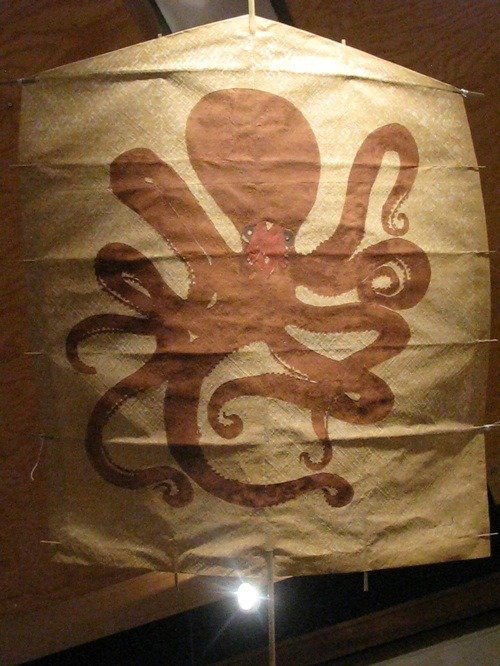
Master Mexican artist Francisco Toledo’s kite
Mexican graphic artists, international kite artists, traditional Japanese kites, contemporary kites and antique ukiyo-e come together in an exciting collaboration between Puebla, Mexico’s Museo Taller Erasto Cortes (MUTEC), Master Mexican artist Francisco Toledo, and Drachen Foundation. The exciting exhibition features four distinct elements, all tied together by the floating world of kites: contemporary Mexican graphic arts transformed into kites, internationally known kite artists using printing techniques on their kites, traditional Japanese kites by Mikio Toki, and antiques ukiyo-e from the Skinner Collection featuring kites.

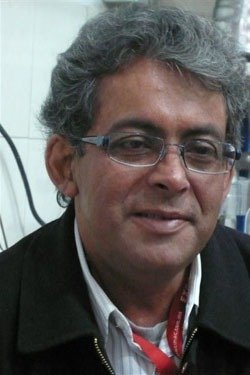
Left: “Alas Sobre un Mundo Flotante” exhibition | Right: MUTEC Director Cesar Gordillo
Puebla, Mexico’s MUTEC is ideally suited to be the first host of this exhibition. It houses the famous collection of graphic arts collected by Erasto Cortes, but also supports working artists with exciting exhibitions of contemporary Mexican graphic arts. Additionally, it hosts professional workshops for working artists, students, and the public. Director Cesar Gordillo was instrumental in choosing the very distinguished Mexican artists to participate in the project. He provided direction and hands-on help in framing the fourteen kites in a variety of traditional Japanese kite shapes.
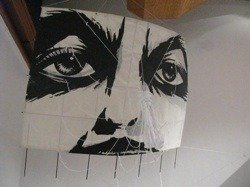
Kite by Robert Trepanier
Seattle’s (Washignton, USA) Drachen Foundation was instrumental in creating the second element of the exhibit. The Foundation contacted six international kite artists and challenged them to use some form of printing as the basis for new kites to be included in the exhibit. Their experience with printing techniques ranged from extensive (in the case of Istvan Bodoczky and Nobuhiko Yoshizumi) to minimal (Jose Sainz and Allessia Marrocu), but the results were exciting. The two groups of kites are a reflection of one another; both show their creator’s artistic journeys to this floating world.
The third exhibit element are the traditional Edo kites of Mikio Toki. With Yoshirau’s “Kite Flying Competition in the Blue Sky” (included in the exhibit) as his guide, Toki-san created all of the kites shown in the print. Sixteen are included in the exhibit and they show several variations upon the traditional Edo-dako as well as the famous yakko-dako. These kites are a direct bridge from the historical ukiyo-e images to today’s traditional kites of Japan.


Left: Traditional Japanese kite by Mikio Toki | Right: Kuniyoshi image from Skinner collection
Scott Skinner has personally loaned ukiyo-e from his collection for inclusion in the exhibit. Nineteen prints are the historical graphic basis for the exhibit. The included prints span a large part of the 19th Century and include images by Hiroshige, Hokusai, Kuniyoshi and others. The floating world, sought by the artists of old Japan, comes to life with this contemporary floating world of artistic kites.
Artists included in the exhibition are:

Francisco Toledo
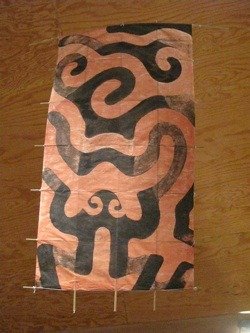
Martin Vinaver
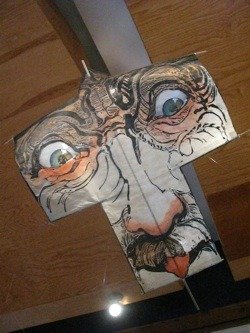
Per Anderson
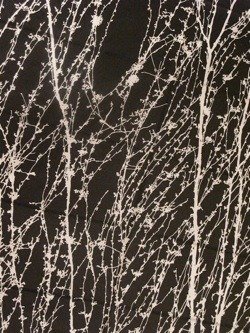
Jan Hendrix

Dr. Lakra
German Montalvo
Javier Marin
Raymundo Sesma
Luis Ricaute
Jose Lazcarro
Paloma Torres
Patricia Cordoba
Joel Rendon
Nunik Sauret
Primary credit for the creation of “Alas sobre un mundo flotante” must go to Maestro Francisco Toledo, who has become entranced with all things papalote. His dedication to raise the humble papalote to such artistic heights is a credit to his dedication, vision, and love. Appropriately, he has created a wonderful tako-tako (octopus kite), included in the exhibit. Cesar Gordillo, director of MUTEC stated that one of Toledo’s dreams was to have a sort of graphic arts highway throughout Mexico. So it will be with “Alas sobre un mundo flotante,” since it will travel for all of 2010 to Veracruz, Oaxaca, and Mexico City.
– Scott Skinner
DF Collections to Receive a “Preservation Needs Assessment”
Gifts came early at the Drachen Foundation Study Center this past December when we were awarded The Conservation Center for Art & Historic Artifacts’ (CCAHA) grant for a Preservation Needs Assessment. The program, valued at about $6,000, is funded by the National Endowment for the Humanities. The CCAHA specializes in the treatment of paper objects and archives, of which, DF has many in its collection. Through the Needs Assessment Program, CCAHA sends one of its highly qualified staff members to survey and assess the preservation system we have in place for our collection, then make detailed recommendations for how we can implement a tailored preservation plan.

Over the next year this assessment will require considerable time, effort, and research on the part of both DF and the Conservation Center. It will involve various DF constituents, staff and Board members, but the process will have important results for the future of the DF collection. The site survey will specifically review our institution’s preservation needs with regards to storage environment (temperature, relative humidity, pollution and light), housekeeping and pest control, object housing practices, handling, exhibition procedures, repair and conservation treatments, and preservation planning. It also includes an overview of physical plant and maintenance, security, and safety procedures.

We are currently preparing for the site visit by focusing on documenting the primary issues and concerns of DF’s collections as well as updating our policies, procedures, and strategic plan for inclusion in the study.
Established in 1977 and based out of Philadelphia, PA the CCAHA is the largest non-profit conservation lab in the country. We are delighted to have been chosen to receive this grant for their services and eagerly look forward to summer or fall of this year when we will work with the preservation assessor on site. For more information about the CCAHA, visit: http://www.ccaha.org/
– Shelly Leavens
Tazzie Adventure
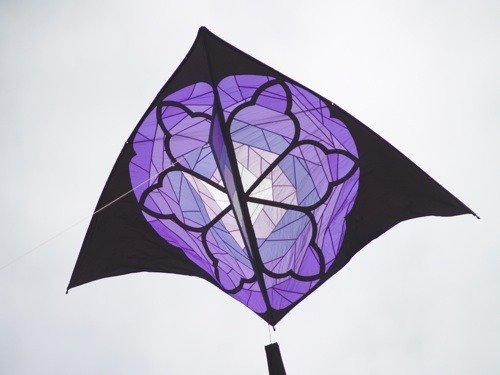
Artist: Rob Brasington
It’s been several years since my wife, Sherry has accompanied me on a “kite trip,” and this trip to Tasmania was anything but a normal kite journey. Having been casually invited by Rob Brasington, the idea of going really took hold when a friend heard us talking about it and asked, “Can I come too?” Well that sealed the deal, now I knew that Sherry would be happy, even if I left her for a day or three of kite flying. Our friend, Sheila, is a great traveler and our only concern was that we might not be quite “exciting” enough for her taste. So now our little group began the planning for two weeks in Australia – to include some decompression days in the big city, Sydney – primarily on the island of Tasmania.
Since I was now outnumbered, we “enjoyed” a night at the Sydney Opera and La Traviata. I guess that’s the price a kite guy has to pay for a weekend at the Bay of Fires. We did venture to Bondi beach for the ladies to gaze at the local boys, but after enjoying the sights, sounds and tastes of Sydney (these included the fruit bats hanging around, and flying out of, the trees of the royal Botanical Gardens), it was off to Hobart, Tasmania for our island adventure. After an enjoyable couple of days in Hobart, it was time to hit the road and drive up the East Coast to the Bay of Fires. I can safely say that you can convince anyone (me) of anything with a credible web presence. I was convinced that we would find bustling beach towns, surfer-dudes, souvenirs, and the works, but what we discovered was an almost untouched area of the world with very few “tourists” regardless of the season (this was the last full week before school started, so again, I assumed that the locals would be out in force – not so!).
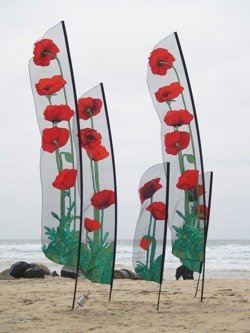

Artist: Diane Della Paoli
What we found when arriving at Rob and Tracy’s beautiful home was that this is an annual event for the Australian Kiteflyers Association (the other AKA). We’d be flying with about 20 members from both the mainland and Tazzie. Saturday gave us a day of high winds, blowing sand, and, for me, completely unexpected tough flying conditions. I guess I wasn’t the only one who felt this way, as we reviewed the day at Rob’s that evening. This had been a very unusual day and I didn’t feel at all guilty about not bringing the ladies to the beach. I tried to make the day a bit more complete by leading a kitemaking class using Yoshizumi-san’s “2 in 1” kits. For most in attendance, this was an introduction to bamboo and paper and we made more than ten kites in the improvised workspaces of Rob and Tracy’s back porch and Rob’s workshop. By the way, it’s worth a trip to Tazmania just to take the tour of Rob and Tracy’s gardens. Spectacular, and the guides are really nice people!
Sunday, we drove down the beach a few kilometers and the day proved to be spectacular. Perfect wind, lovely beach, ice cream stand just a few strides away – perfect! Even Sherry and Sheila enjoyed staying out all day and watching the great show put on by Rob and the rest of the Australians. I enjoyed an afternoon of team-Rev flying. Something that I’m forbidden to do on the North American Continent. A truly memorable place and time.
I suppose when I start blogging, I’ll talk about the last week in Tazzie, but I’m afraid you’ll all have to wait for that. It’ll happen right after I’ve joined “Facebook.”
– Scott Skinner
The Way We Were and the Way We Are


This is one of many “chatty” updates from the helm of the Drachen Foundation to give you an idea of where we are headed in the next three years. In my article in Discourse, “The Past, The Present and Our Future” (August, 2009), I outlined what our Board envisions for the Drachen Foundation – a state of the art storage facility for our kites with full digital access to the collection on line.
I am happy to announce we are right on track with these goals. Our staff is professionally trained, we are writing and receiving grants and funding to create the best place for the collection, and we are adding new on-line content daily.
In order to focus the resources necessary to achieve this vision, we are beginning to cut back our presence in kite programming, traveling exhibits, and giving. This will be our last year of soliciting for projects. After 15 years of programming and grant giving we have personally experienced the grand view of the kiting world which we now want to share on the web through enhanced documentation, articles, interviews, research and content. We will convert our travelling exhibits, which were previously viewed by limited audiences, to virtual exhibits which can be viewed by anyone with access to the web for the enjoyment of individuals and use by scholars and educators. The exhibits are not going away so much as “morphing” into a new medium for public access.
Our new direction will give better international access of all our collection. What good is a collection if there isn’t access? Storing it is a good thing, but even better is access and the ability for anyone to become a researcher, to cross reference and study our collections, without having to fly to the Seattle area to investigate.
But don’t think we will disappear into our offices, never to be seen by the kiting community! In fact, it’s the opposite, as the DF Board and I make more visits to individuals and sites to document what’s happening in the world of kiting. This year our travels and conversations reflect the work we have committed ourselves to in networking and collaborating with organizations in Mexico, Tasmania, Japan, Germany, and Seaside, Oregon for the AKA convention. Working to document the world of kites keeps us moving! Keep watching our newsletter and web for more collection updates!
– Ali Fujino
Memories of Kites, Kite People: a Conversation with John Dusenberry

John showing two of the kites he collected in Japan on a Checkley trip
John Dusenberry is one of the earliest of Seattle kite enthusiasts who found passion in the world of kiting and still remains “curator” of a personal collection of kites, books and memorabilia at his home in the neighborhood of Phinney Ridge, Seattle.
Our introduction to John was through a neighbor, a friend of the foundation, David Baldwin (we are grateful for the effort of these friends, as this is how many important kite enthusiasts are “found, not lost.”), and contact was made with Shelly Leavens, DF collection manager.
Shelly spent many days with John and these are a few of her notes on the life and passion of his kite world.
Click the play button below to hear a clip of John Dusenberry describing his experience at Hamamatsu. John’s full oral history is archived at DF.
Communities manifest themselves in many ways – in forms that shift and transform the people who move through them. John Dusenberry knows well the nature and power of community in his life – through his profession of optometry and hobbies of kayaking, cycling, sailing, hot-air ballooning, flying airplanes, and as you may have guessed, flying kites.

John looking through some of the Japanese kite books he got from Takeshi Nishibayashi (now in DF collection)
John got into kites in the early 1970s when he read an article about parafoils in Popular Science, where fellow Seattleite David Checkley was mentioned. Curious about kites and wanting to connect to people with a similar curiosity led him to contact Checkley. It wasn’t long before he was drawn into the small group of kite enthusiasts in Seattle, including Checkley, Jack Van Gilder, Tom Sisson, Ken Conrad and Harold Writer. In 1973 they decided to form the Washington Kitefliers Association (WKA) with Checkley as the first president. John was the WKA secretary in 1975, then president the following year. He was still just a beginning kite flyer at the time, but comfortable with the group. “There were experts there, but most of us were casual people,” he said.
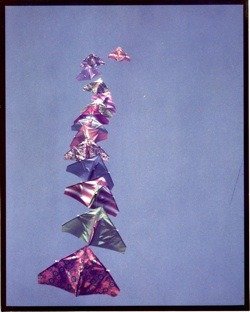
John’s 45-kite train
I met with John in his small house tucked on a hillside in the Phinney Ridge neighborhood, where he has lived for more than 40 years. His space is filled with eclectic objects collected through his interests, all playing a part in the tales of his life. As we spoke, John continually mentioned his favorite tissue paper kite train. He made few kites, but those he did make withstood much use – from being flown in the middle of the University of Washington football game half-time show, to the beaches of Golden Gardens Park – a few tried and true kites were all John needed. John took his favorite kites with him when he traveled with Checkley and Co. to both Japan and China in the late 70s and early 80s. He vividly recalls these adventures, just as much for the kite experiences as for the cultural exposure. He describes the colors, sounds and high energy of the Hamamatsu fighter kite competition as if he were there yesterday. “They go out and try to cut each other’s kites from the sky. As the kite falls out of the sky the team runs up and takes it back, another team repairs it, and tries to get it back up in the air. And the sky is full of these traditional Japanese kites. That goes on for a week!” he says, leaning forward in his chair, eyes intense with memory.
Exciting as it may have been, for John, kite flying had a different feel. Not competitive, not frenetic. “I’m more the kind of person that wants to get the kite up in the air, drive a stake in the ground, wrap the string around it, lie down and enjoy. That’s the kind of kite flying that I like,” he says as he laughs.

John with his Harold Writer winder, also now in the DF collection
Now 82 years old, John is still active with his latest routine of walking to the Woodland Park Zoo every day. He has gotten to know each young gate-person by name and showed me all of their smiling faces on his camera. This is one of the ways he continues to stay connected to the people and place of his neighborhood. “My interest in kiting waned when Jack Van Gilder and David Checkley died,” John commented wistfully. “They were my companions, the people I looked up to. It was just as much about the relationships with people, as it was about the kites. It was an integral part in my interest in kiting.” So now, while John no longer flies kites, and is part of a different community, the people, places, and kites of his past have not left him. Right next to his chair is a framed portrait of his trusty kite train.
– Shelly Leavens
Relegated to the Back Room
As I was starting to organize all of the assorted objects that are not kites for the annual trip to the Nevada/California desert for this year’s NABX (North American Buggy Expo), I had to rummage through a variety of things in the “back room.” I religiously use my buggy once a year, rain or shine, so sometimes I might forget what, exactly, has been placed in “storage.” While rummaging, I found an object that had been relegated to the back room, and it made me think of the kiteflyer of 100 years ago.
Would he have had an automobile? If so, space for other-than-kites would have been at a premium. He would have had kite line and reels, ground anchors, protection from the weather, food, and drink. He might have had hunting kites – used to flush game birds or maybe to keep them on the ground so his dog could do the work! I’m pretty sure several of the the Aigloplan kites could have been used this way.

An Owl Aigloplan kite, probably used for hunting

Hunting bird kite of unidentified manufacture, probably French, with drogues and line
I won’t have hunting kites with me, but the rest is not unlike the list of stuff that’s going with me to Ivanpah Dry Lake Bed: tent, sleeping bag, chairs, buggy bag with helmet and pads, tools, spare parts, and so forth. (See www.NABX.net for details on this year’s event.)
But the well-appointed gentleman kiteflyer might also have had the latest wind indicator: the Freres Richard Anemometre (Richard Brothers’ Anemometer). Here was an instrument that could accurately measure wind velocity in meters-per-second. Made of heavy chromed steel, it includes a stopwatch with sweep-second-hand as well as the wind indicator with two hands. It could measure meters-per-second to the 100th of a meter!
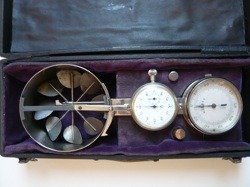

The well-appointed kiteflyer of today has even more technology at his fingertips: and it comes in an even smaller package. With an iPhone and the application called Wind Meter (duh), the flyer can accurately find windspeed recorded in mph, knots, kph, meters per second, feet per second, or Beaufort. Amazing! But gets better; with the app called WindAlert, and connection to the “interweb,” you can actually see the wind forecast for your location. This is a great tool for the flyer who wants to waste no time waiting for wind, instead he’s the one who arrives on the field right when the wind gets good. Of course this technology isn’t foolproof, you’ve got to be in a location with electronic access and, the forecasts have to be accurate. Certainly, though it’s a great way to double-check what you see out the window.
So, back to packing and I’ll leave the anemometer in the back room. This time.
– Scott Skinner


